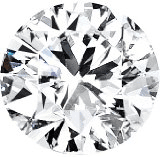
When you want to buy a diamond, there are a lot of different type of diamond cuts and shapes available. Of all the diamond shapes, the Round cut diamond is the most well-known and is most often used in engagement rings and wedding rings. Though its shape is very simple, its brilliance and elegance is unmatched.
The Round cut diamond is often referred to as the Round Brilliant Cut or Brilliant Cut.
With over three quarter of all diamonds used in jewellery designs being a Round Brilliant Cut diamond, we can argue that it is not only the most recognisable cut but also the most popular diamond cut. This is because a round diamond has the greatest brilliance and fire when compared to the other diamond shapes.
The Round Brilliant Cut was developed by Marcel Tolkowsky around 1919 as part of his PhD thesis in mathematics. Tolkowsky developed the Round Brilliant Cut by considering variables such as the index of refraction and covalent bond angles in his calculation that produces the maximum fire and brilliance of the stone.
Even, nearly 200 years later, the Round diamond is still the most popular choice for people buying a diamond, followed by the Princess Cut diamond. The Princess Cut diamond is square in shape and due to its shape; it does not sparkle as much as the Round diamond.
Why Round Brilliant Cut Diamonds Are More Expensive Than Other Cuts
Rough diamonds are formed in an octahedron shape. When the rough is cut in half, you are left with 2 square faced halves. For a diamond cutter to transform the rough into a round brilliant cut diamond, roughly 35% of the diamond is lost therefore there is a lot of wastage and money lost in the process.
Round Cut Diamond Engagement Ring
One reason Round Cut diamonds are popular in engagement rings, is because the shape does not limit the designing of the engagement ring. It can be used with any other diamond shape, be positioned on its own, which we call a solitaire ring or be displayed in a three stone setting. The round cut diamond can also be used as accent stones for pave and channel settings.
Buying A Round Diamond – What You Need To Know
Before going out and buying a round cut diamond, it is a good idea to try to find out which diamond shape your significant other preferred. Obviously you want to buy for her the diamond and diamond ring she has always dreamt about. If you are trying to keep the process a secret, ask a friend of hers to find out for you.
 As far as the diamond is concerned, of course a GIA certified diamond is a necessity; this eliminates the worry and the heartache of doubting your supplier. A GIA certificate tells you what the diamond is how well it is cut, it’s polish and Symmetry and whether the diamond has fluorescence. Most GIA certified diamonds have their certificate number lazer inscribed on the girdle of the diamond.
As far as the diamond is concerned, of course a GIA certified diamond is a necessity; this eliminates the worry and the heartache of doubting your supplier. A GIA certificate tells you what the diamond is how well it is cut, it’s polish and Symmetry and whether the diamond has fluorescence. Most GIA certified diamonds have their certificate number lazer inscribed on the girdle of the diamond.
Triple Excellent Cuts Explained
Only with round brilliant cut diamonds does GIA specify cut (total brilliance) the cut of the diamond determines how much light is transferred through the diamond back to the viewers vision. Cuts can be good very good or excellent, the best being excellent. The difference between a very good cut and an excellent cut diamond is minimal to an untrained eye. However it would make a difference to the overall price of the diamond.
The other elements that can be excellent are the polish and Symmetry, the polish in the diamond is the smoothness of each and every facet, after cutting a diamond into it’s 57 o facets, the diamond cutter goes over each facet in the diamond and makes sure that there are no polishing lines left on the facets, provided that there are no polishing lines left on any of the 57 facets the diamond is graded as having an excellent polish.
 Think of Symmetry as dissecting anything and having two parts that are similar in every way. Same with a diamond if dissected into two, both sides should be exactly and equally similar, in a Round brilliant cut, if the diamond is cut into 8 equal parts all facets on all the 8 parts should be exactly similar for the diamond to be called excellent in it’s symmetry.
Think of Symmetry as dissecting anything and having two parts that are similar in every way. Same with a diamond if dissected into two, both sides should be exactly and equally similar, in a Round brilliant cut, if the diamond is cut into 8 equal parts all facets on all the 8 parts should be exactly similar for the diamond to be called excellent in it’s symmetry.
Does excellent symmetry mean that the diamond sparkles more. The answer is No. The diamond is brighter when the angle of the pavilion is at it’s optimum, so is the angle of the crown, and the overall depth of the diamond is in perfect proportion to the size of the table, hence capturing and reflecting every bit of light that has gone into the diamond.
Quick Quote:

